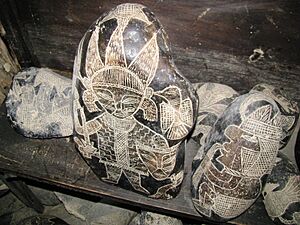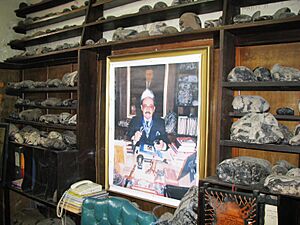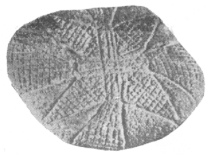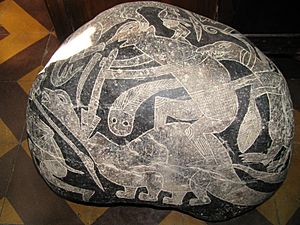Ica stones facts for kids
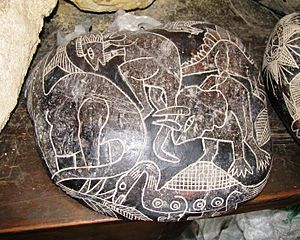
The Ica stones are a group of andesite stones found in the Ica Province of Peru. They are famous for their interesting pictures carved into them. Most people believe these stones are modern hoaxes, meaning they are fake. The carvings often show things that don't fit the time period, like dinosaurs and advanced technology.
People first reported seeing engraved stones in Peru in the 1400s, during the time of the Spanish conquest. However, very few similar stones have been found by archaeologists. In the 1960s, many stones like the Ica stones started appearing for sale.
The most well-known collection of Ica stones belongs to a doctor named Javier Cabrera Darquea. He bought about 20,000 stones from a farmer named Basilo Uschuya. Cabrera believed the stones proved that an ancient, very smart civilization once lived in Peru. Later, Uschuya admitted that he had made the stones himself. Other farmers also said they made such stones.
Since these stones have never been found by archaeologists, and there's no other proof of a super-advanced ancient civilization, it's very unlikely such a society existed. The dinosaurs shown on the stones look like how people thought dinosaurs looked in the 1960s. Also, some of the dinosaurs shown didn't even live in South America. This makes it unlikely that ancient people actually saw these dinosaurs. Even though most experts see them as fakes, the Ica stones are popular among groups who believe in pseudoscience.
It's possible that a few of the Ica stones are real ancient artifacts. This is mainly thought to be true for stones not in Cabrera's collection. These possible real stones have more typical ancient Peruvian designs.
Contents
What are the Ica Stones?
The Ica stones are all said to come from the Ica Province in Peru. They are made of grey andesite, which is a type of volcanic rock. The stones come in many sizes, from tiny ones just a few centimeters wide to large boulders over half a meter across. Most of them are quite small.
All the stones have a dark outer layer called a patina. The pictures are carved by scratching through this dark surface. This patina is quite thin and soft, making it easy to scratch.
History of the Ica Stones
How the Stones Became Known
People have known about engraved stones in the Ica region for a long time. Records from the 1400s mention similar artifacts. However, early archaeological digs in the late 1800s and early 1900s didn't find any engraved andesite stones. Still, people who illegally dug up ancient graves (called huaqueros) started selling engraved stones to tourists.
Today, there are a huge number of Ica stones known, possibly between 50,000 and 100,000.
Javier Cabrera's Collection
The most famous collection of Ica stones belonged to Dr. Javier Cabrera Darquea (1924–2001). Cabrera said his interest began in 1966 when a friend gave him an engraved stone as a birthday gift. He thought the carving showed a prehistoric fish.
Cabrera bought many more stones from collectors and a farmer named Basilo Uschuya. By the late 1970s, Cabrera had over 11,000 engraved stones. He also had stones his father supposedly found in the 1930s. Cabrera was a doctor, but he kept his interest in the stones a secret at first. By 1970, his collection and ideas became well-known.
In 1996, Cabrera opened a museum called the Museo de Piedras Grabadas (Museum of Engraved Stones). He displayed his collection, which grew to about 20,000 stones by the end of his life. The museum is still a tourist spot today.
Cabrera called the stones "gliptoliths." He wrote a book saying the stones were made by an ancient type of human called "Gliptolithic Man." He believed these humans had big brains and could use their minds to control things in outer space. Cabrera thought they left Earth before the Cretaceous–Paleogene extinction event (when dinosaurs died out) to travel to a planet near the Pleiades star cluster. He also thought they built the Egyptian pyramids. Most experts do not believe Cabrera's ideas.
Santiago Agurto Calvo's Collection
Another person who collected Ica stones was Santiago Agurto Calvo, a university leader. Calvo bought many stones and also organized searches in old cemeteries. In 1966, he reported finding an engraved stone in an ancient tomb. He believed these stones were part of old burial traditions.
Calvo told the Regional Museum of Ica about his finds. He even went on more expeditions with the museum's expert. They reported finding more engraved stones in ancient tombs. These stones were small and had designs like flowers or fish.
In 1968, Calvo gave some of his stones to the Regional Museum of Ica. They were displayed as "pre-Inca burial art." However, in 1970, the museum removed them. This happened after Cabrera's collection became famous, and the museum started to think the stones were hoaxes.
What Do the Ica Stones Show?
The Ica stones have many different kinds of pictures carved into them. Some are simple drawings, while others are very detailed. Some designs look like art from ancient Peruvian cultures, such as the Paracas or Inca.
Dinosaurs on Stones
Many stones show pictures of extinct animals, especially different kinds of dinosaurs. These include meat-eating dinosaurs (like theropods), long-necked dinosaurs (like sauropods), horned dinosaurs (like ceratopsians), and armored dinosaurs (like stegosaurs). Some stones also show flying reptiles called pterosaurs.
The stones only show extinct animals that scientists already knew about when the stones appeared. No dinosaur bones have been found in the Ica area. Also, some dinosaurs shown, like ceratopsians, never lived in South America.
Sometimes, the stones show humans hunting or even riding dinosaurs. Some scenes seem to show humans fighting dinosaurs. Some carvings even suggest humans knew how to hit a dinosaur's weak spots.
Many of the dinosaurs on the Ica stones look like old drawings of dinosaurs from the 1960s. For example, a Tyrannosaurus-like dinosaur is shown standing upright and dragging its tail. This was how artists drew Tyrannosaurus in the 1960s, but scientists now know they walked with their bodies more level and tails off the ground. Also, some dinosaur carvings show them with five fingers and toes, which is not correct based on fossils. Some stones even show dinosaurs changing from larvae into adults, which is not how real dinosaurs grew. One stone shows a human riding a Pteranodon-like pterosaur, which would have been impossible because the animal couldn't carry a human's weight.
Humans and Technology

The humans carved on the stones look like people from the ancient Inca or Aztec cultures. Some stones seem to show very advanced technology that didn't exist back then. These include doctors doing complex surgeries, acupuncture, genetic engineering, people looking at the sky with telescopes, flying machines, and spaceships. The surgeries shown include heart and brain surgeries, and organ transplants.
Most human figures have big heads and long noses. They look different from other known ancient cultures in the area. They wear simple clothes like loincloths and feather headdresses. When fighting, they use axes and spears, even though other carvings show advanced technology. People who believe the stones are real say that cultures might develop technology in different ways.
If a society as advanced as the one shown on some stones really existed, we would expect to find more proof. We would see ruins of advanced buildings, old trash, and graves. But none of this has been found.
Other Designs
Some stones show maps of land or stars. Other stones have pictures of flowers, fish, or animals that live today. Sometimes, these animals, like kangaroos, are not found in Peru.
Why Are They Considered Hoaxes?
How the Fakes Were Discovered
After a TV show questioned the stones, Peruvian authorities started investigating. Selling ancient cultural items is against the law. Basilo Uschuya, the farmer who sold many stones to Cabrera, was arrested. He admitted that he and his wife made the stones themselves. They said they did it to make money from tourists and to inspire writers who believed in strange historical theories. They got ideas for the carvings from comic books, school books, and magazines. After being released, Uschuya kept making and selling similar stones, but he didn't pretend they were real anymore.
Uschuya explained how he made the stones look old. He baked them in animal waste and rubbed them with shoe polish to create the dark patina. He used a dentist's drill, knives, and chisels to carve the pictures. He said making a stone could take as little as 15 minutes.
Even with Uschuya's confession, some people who believed the stones were real were not convinced. They thought he only confessed to avoid jail. They also wondered how a poor farmer could make tens of thousands of stones. However, Uschuya was not the only farmer who admitted to making these stones. In later interviews, Uschuya sometimes confirmed the hoax and sometimes said he only claimed it to avoid prison. In one interview, he said Cabrera had "about 5000 genuine stones" in his collection, meaning real ones or ones made by someone else.
There is no proof that Dr. Cabrera worked with Uschuya to create fake stones. Cabrera seemed to genuinely believe the stones were real. He thought the stones Uschuya made were just copies of real, original stones. Cabrera also claimed there were real hidden collections of stones in a secret cave. However, no one has ever found this cave.
Some designs on the stones clearly show ideas that were popular around the time the stones were "discovered."
Are Any Stones Real?
It's possible that some of the Ica stones are real ancient artifacts. This idea is supported by old Spanish records that mention similar engraved stones. The huge number of stones can be used as an argument both for and against their authenticity. A large number might suggest they were made in bulk for tourists.
No studies have been done to try and find any truly genuine stones within the collections. Even if some of the more unusual stones were real, their pictures might not mean what people claim. The carvings are very stylized, and it's often hard to tell exactly what they show.
The stones that Santiago Agurto Calvo gave to the Regional Museum of Ica might be real. Unlike Cabrera's stones, Calvo's stones have shallower carvings and don't show extinct animals, strange humans, or advanced technology. Their designs are typical of ancient Peruvian art, like flowers and birds. If Calvo's stones were proven real, it wouldn't mean Cabrera's more unusual stones are also real.
Cabrera said that andesite is a hard stone and difficult to carve without modern tools. However, the stones are not carved deeply but engraved by scratching the surface. Also, many ancient cultures in Peru had advanced metal tools, not just stone tools.
See also
 In Spanish: Piedras de Ica para niños
In Spanish: Piedras de Ica para niños
- Acámbaro figures
- Out-of-place artifact
- Rock art


